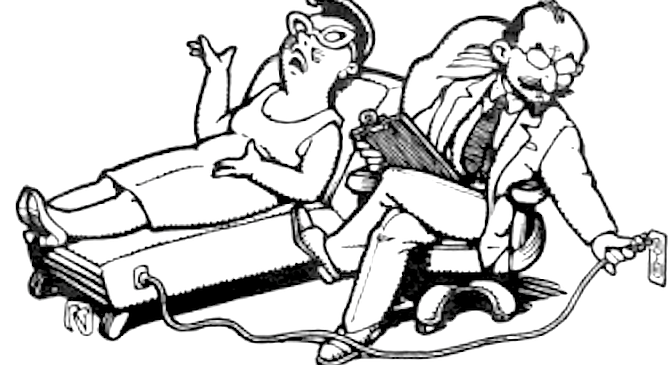 Facebook
Facebook
 X
X
 Instagram
Instagram
 TikTok
TikTok
 Youtube
Youtube

Dear Matt: Exactly what is shock therapy, and does it work? If so, how? What is it supposed to fix? — Bill Hunt, [email protected]
Shock therapy? Well, just last week we took Ma Alice to Edie’s Fat ’n Foxy Shop for the big end-of-summer spandex blowout. Fixed any yen I had to go to the beach for a while. Not what you had in mind, eh. Well, then you must mean electroconvulsive therapy, ECT. It’s one of the oldest psychiatric therapies still in use and definitely one of the most controversial. As it’s administered these days, a patient is anesthetized and given muscle relaxers and oxygen; electrodes are placed on each side of the skull, near the temples; a bite block goes into the patient’s mouth, and a brief pulse of electricity is sent into the brain. Nerve pathways in the brain start firing, and, basically, the patient has a medically induced seizure. The electrical activity releases floods of brain chemicals, which may be the key to the therapy’s effectiveness. The whole process takes about 15 minutes, after which the patient is groggy and has some memory loss. Treatments are repeated periodically; ECT is not a “cure.”
Why would anyone go through this? It’s increasingly the procedure of choice for treating acute, prolonged depression (and sometimes schizophrenia) that has not responded to medications or other standard therapies. It has the blessing of the AMA, the American Psychiatric Association, and other medical groups. The most vocal opponents are some of the people who’ve actually experienced it. There are about 1000 members of a group called the International Association of Shock Survivors, who claim severe personality changes, permanent memory loss, and other debilitating side effects. They also point out that medicine does not know exactly how ECT works, so maybe it’s risky to be treating people’s brains like light bulbs.
ECT does suffer from a major image problem. One Flew Over the Cuckoo's Nest about sums it up. In the ’40s and ’50s it was misused to control unruly psychiatric patients in mental hospitals, and fewer precautions were taken to protect patients from the physical dangers of the seizures. At that time, psychiatry thought the shock treatments wiped out unpleasant memories that caused depression. In the 1960s, when biochemistry replaced Freud as the framework for treating psychiatric conditions, ECT lost popularity. But it’s coming back. Depending on which figures you believe, anywhere from 50,000 to 100,000 Americans will have ECT in the next year.
Italian psychiatrists were the first, in the 1930s, to use a form of ECT on schizophrenic patients. It apparently was a technological update of an older remedy that called for applying electric eels to a sufferer’s head.


Dear Matt: Exactly what is shock therapy, and does it work? If so, how? What is it supposed to fix? — Bill Hunt, [email protected]
Shock therapy? Well, just last week we took Ma Alice to Edie’s Fat ’n Foxy Shop for the big end-of-summer spandex blowout. Fixed any yen I had to go to the beach for a while. Not what you had in mind, eh. Well, then you must mean electroconvulsive therapy, ECT. It’s one of the oldest psychiatric therapies still in use and definitely one of the most controversial. As it’s administered these days, a patient is anesthetized and given muscle relaxers and oxygen; electrodes are placed on each side of the skull, near the temples; a bite block goes into the patient’s mouth, and a brief pulse of electricity is sent into the brain. Nerve pathways in the brain start firing, and, basically, the patient has a medically induced seizure. The electrical activity releases floods of brain chemicals, which may be the key to the therapy’s effectiveness. The whole process takes about 15 minutes, after which the patient is groggy and has some memory loss. Treatments are repeated periodically; ECT is not a “cure.”
Why would anyone go through this? It’s increasingly the procedure of choice for treating acute, prolonged depression (and sometimes schizophrenia) that has not responded to medications or other standard therapies. It has the blessing of the AMA, the American Psychiatric Association, and other medical groups. The most vocal opponents are some of the people who’ve actually experienced it. There are about 1000 members of a group called the International Association of Shock Survivors, who claim severe personality changes, permanent memory loss, and other debilitating side effects. They also point out that medicine does not know exactly how ECT works, so maybe it’s risky to be treating people’s brains like light bulbs.
ECT does suffer from a major image problem. One Flew Over the Cuckoo's Nest about sums it up. In the ’40s and ’50s it was misused to control unruly psychiatric patients in mental hospitals, and fewer precautions were taken to protect patients from the physical dangers of the seizures. At that time, psychiatry thought the shock treatments wiped out unpleasant memories that caused depression. In the 1960s, when biochemistry replaced Freud as the framework for treating psychiatric conditions, ECT lost popularity. But it’s coming back. Depending on which figures you believe, anywhere from 50,000 to 100,000 Americans will have ECT in the next year.
Italian psychiatrists were the first, in the 1930s, to use a form of ECT on schizophrenic patients. It apparently was a technological update of an older remedy that called for applying electric eels to a sufferer’s head.
Comments